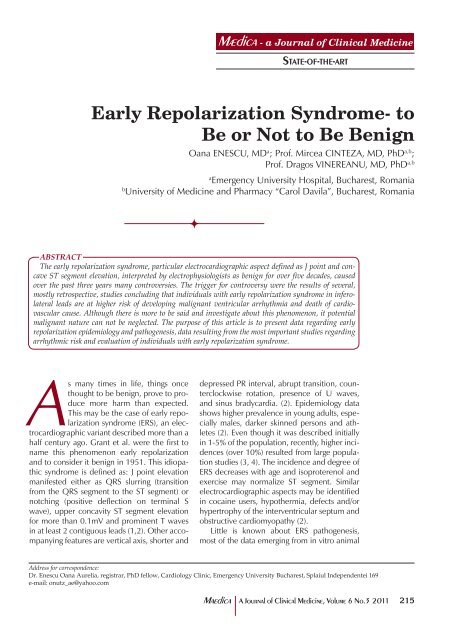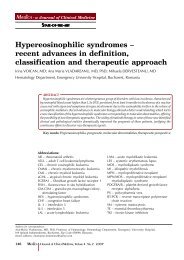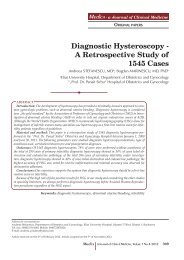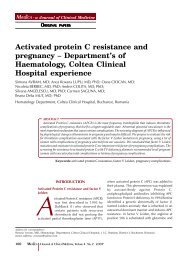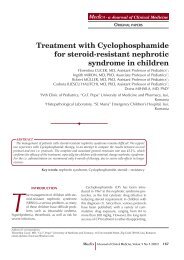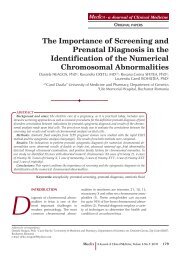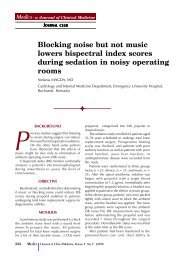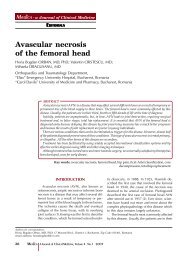Early Repolarization Syndrome - MÃDICA - a Journal of Clinical ...
Early Repolarization Syndrome - MÃDICA - a Journal of Clinical ...
Early Repolarization Syndrome - MÃDICA - a Journal of Clinical ...
Create successful ePaper yourself
Turn your PDF publications into a flip-book with our unique Google optimized e-Paper software.
Mædica - a <strong>Journal</strong> <strong>of</strong> <strong>Clinical</strong> Medicine<br />
STATE-OF-THE-ART<br />
<strong>Early</strong> <strong>Repolarization</strong> <strong>Syndrome</strong>- to<br />
Be or Not to Be Benign<br />
Oana ENESCU, MD a ; Pr<strong>of</strong>. Mircea CINTEZA, MD, PhD a,b ;<br />
Pr<strong>of</strong>. Dragos VINEREANU, MD, PhD a,b<br />
a<br />
Emergency University Hospital, Bucharest, Romania<br />
b<br />
University <strong>of</strong> Medicine and Pharmacy “Carol Davila”, Bucharest, Romania<br />
ABSTRACT<br />
The early repolarization syndrome, particular electrocardiographic aspect defined as J point and concave<br />
ST segment elevation, interpreted by electrophysiologists as benign for over five decades, caused<br />
over the past three years many controversies. The trigger for controversy were the results <strong>of</strong> several,<br />
mostly retrospective, studies concluding that individuals with early repolarization syndrome in inferolateral<br />
leads are at higher risk <strong>of</strong> developing malignant ventricular arrhythmia and death <strong>of</strong> cardiovascular<br />
cause. Although there is more to be said and investigate about this phenomenon, it potential<br />
malignant nature can not be neglected. The purpose <strong>of</strong> this article is to present data regarding early<br />
repolarization epidemiology and pathogenesis, data resulting from the most important studies regarding<br />
arrhythmic risk and evaluation <strong>of</strong> individuals with early repolarization syndrome.<br />
As many times in life, things once<br />
thought to be benign, prove to produce<br />
more harm than expected.<br />
This may be the case <strong>of</strong> early repolarization<br />
syndrome (ERS), an electrocardiographic<br />
variant described more than a<br />
half century ago. Grant et al. were the first to<br />
name this phenomenon early repolarization<br />
and to consider it benign in 1951. This idiopathic<br />
syndrome is defined as: J point elevation<br />
manifested either as QRS slurring (transition<br />
from the QRS segment to the ST segment) or<br />
not ching (positive deflection on terminal S<br />
wave), upper concavity ST segment elevation<br />
for more than 0.1mV and prominent T waves<br />
in at least 2 contiguous leads (1,2). Other accom<br />
pa n ying features are vertical axis, shorter and<br />
depressed PR interval, abrupt transiti on, counterclockwise<br />
rotation, presence <strong>of</strong> U wa ves,<br />
and sinus bradycardia. (2). Epidemiology data<br />
shows higher prevalence in young adul ts, especially<br />
males, darker skinned persons and athletes<br />
(2). Even though it was described ini tially<br />
in 1-5% <strong>of</strong> the population, recently, higher incidences<br />
(over 10%) resulted from lar ge population<br />
studies (3, 4). The incidence and de gree <strong>of</strong><br />
ERS decreases with age and isopro tere nol and<br />
exercise may normalize ST segme nt. Similar<br />
electrocardiographic aspects may be identified<br />
in cocaine users, hypothermia, defects and/or<br />
hypertrophy <strong>of</strong> the interventricular septum and<br />
obstructive car dio myopathy (2).<br />
Little is known about ERS pathogenesis,<br />
most <strong>of</strong> the data emerging from in vitro animal<br />
Address for correspondence:<br />
Dr. Enescu Oana Aurelia, registrar, PhD fellow, Cardiology Clinic, Emergency University Bucharest, Splaiul Independentei 169<br />
e-mail: onutz_ae@yahoo.com<br />
Maedica A <strong>Journal</strong> <strong>of</strong> <strong>Clinical</strong> Medicine, Volume 6 No.3 2011<br />
215
EARLY REPOLARIZATION SYNDROME- TO BE OR NOT TO BE BENIGN<br />
studies, as in vivo studies are limited by anesthetic<br />
use. Ventricular repolarization occurs<br />
when depolarization ends, the transition from<br />
the latter (J point on ECG) lasting less than 10<br />
miliseconds; any factor interfering with excitation<br />
wave propagation or cellular excitability<br />
recovery reduces or increases duration. Many<br />
electrophysiological studies have identified the<br />
voltage-gated inward and outward currents involved<br />
in repolarization: Ca, Na, Cl and most<br />
important K currents. Numerous types <strong>of</strong> channels<br />
modulate these currents, changes in their<br />
dispersion or structure directly influencing repolarization.<br />
For example long QT syndrome<br />
or Brugada syndrome underlying causes are represented<br />
by genetic changes in ion channels<br />
structure and consecutively function. The relatively<br />
small currents that determine the plateau<br />
phase <strong>of</strong> action potential alterations induce<br />
ma jor changes in repolarization process. What<br />
is to be remembered in order to better understand<br />
ERS, is the fact that experimental studies<br />
have demonstrated that functional expression<br />
<strong>of</strong> ion channels in ventricles changes during<br />
nor mal development <strong>of</strong> the heart as well as in<br />
va rios pathological or non pathological situations<br />
that influence cardiac activity. Little is known<br />
about the underlying mechanism (5).<br />
J point elevation and ST segment elevation<br />
are the key features <strong>of</strong> ERS. ST segment corresponds<br />
temporally to plateau phase, the normal<br />
ECG ST segment aspect indicating the absence<br />
<strong>of</strong> a significant voltage gradient during<br />
ven tricular repolarization (5). Pathological ST<br />
ele vation is a marker <strong>of</strong> myocardial injury, as a<br />
re sult <strong>of</strong> voltage gradient among different myocardial<br />
layers due to ischemia, but this is not<br />
the case in a normal heart.<br />
The most discussed hypothesis incriminates<br />
a voltage gradient across the ventricular wall<br />
during repolarization generated by Ito channels<br />
heterogeneity (Ito current is the most important<br />
determinant <strong>of</strong> ST segment behavior). The difference<br />
in Ito-mediated action potential spike<br />
and dome between ventricular epicardium and<br />
endocardium produces a transmural voltage<br />
gra dient during early repolarization that may<br />
generate J wave elevation. Another opinion regarding<br />
the underlying mechanism speculates<br />
involvement <strong>of</strong> localized depolarization abnormalities<br />
with repolarization anomalies derived<br />
from the first (as in type 1 Brugada syndrome).<br />
Nevertheless there is a possibility that both mechanisms<br />
are responsible for ERS, but further<br />
information is required based on molecular<br />
techniques, morphologic imaging, voltage map<br />
p ing, genetic pr<strong>of</strong>iling in familial cases, autopsy<br />
studies <strong>of</strong> the ventricular area corresponding<br />
to the electrocardiographic changes.<br />
Ge ne tic changes in ionic channel properties<br />
were incriminated, but no sustained genetic<br />
pro filing was ever performed. Recently a mutation<br />
<strong>of</strong> gene KCNJ8 responsible for the porefor<br />
ming subunit Kir6.1 <strong>of</strong> the IK ATP<br />
channel was<br />
identified in individuals with idiopathic ventricular<br />
fibrillation (2, 4, 6, 7). Other possible<br />
explanations are related to anatomic nervous<br />
system disturbances in favor <strong>of</strong> vagotonia and<br />
acceleration <strong>of</strong> conduction in cardiac by pass<br />
tracts (4).<br />
Often misdiagnosed as myocardial infarction,<br />
pericarditis or other diseases that involve<br />
ST segment elevation, ERS was considered as<br />
not having any clinical implication, until several<br />
clinical population studies “cast a spell” on its<br />
innocence. Experimental studies, case reports<br />
and clinical studies have shown ERS potential<br />
arrhythmogenic effect. In 2000, based on preclinical<br />
experimental work, Antzelevitch suggested<br />
that ERS should not be considered as<br />
normal or benign ECG abnormality, unless otherwise<br />
proven, as under certain conditions<br />
known to predispose to ST-segment elevation,<br />
pa tients with ERS may be at higher arrhythmogenic<br />
risk (4).<br />
Until 2008 most <strong>of</strong> the clinical data came<br />
from case reports primarily involving Asian individuals<br />
with idiopathic arrhythmia and ERS.<br />
In 2008, Haissaguerre et al. reported higher<br />
incidence <strong>of</strong> recurrent ventricular fibrillation in<br />
subjects with repolarization abnormality than<br />
in those without by reviewing data <strong>of</strong> 206 subjects<br />
resuscitated after cardiac arrest due to idiopathic<br />
ventricular fibrillation. Data was collected<br />
from centers in 22 countries, subjects<br />
less than 60 years were enrolled (for avoiding<br />
higher incidence <strong>of</strong> cardiac structural disease)<br />
and was compared to that <strong>of</strong> a control group<br />
(412 subjects matched as age, sex, race and<br />
phy sical activity). Information about history <strong>of</strong><br />
syn cope (personal and familial), level <strong>of</strong> physical<br />
activity, results on signal-averaged electrocardiography<br />
and pharmacological testing (at<br />
baseline, 6 and 12 months) was corroborated<br />
with results on electrophysiological testing with<br />
the use <strong>of</strong> multielectrode catheters. ERS occurred<br />
in 64 case subjects 31%, <strong>of</strong> case subject as<br />
compared with 5%, control subjects (p
EARLY REPOLARIZATION SYNDROME- TO BE OR NOT TO BE BENIGN<br />
with a greater magnitude in case subjects than<br />
in control subjects (p0.2<br />
mV) in inferior leads and horizontal/descending<br />
ST-segment, the hazard ratio <strong>of</strong> arrhythmic<br />
death increased to 3.14 but in subjects with<br />
ascending ST variant, the relative risk for arrhythmic<br />
death was not increased (14).<br />
There is little data regarding cardiac structure<br />
and function in ERS individuals, echocardiographic<br />
studies during the last decade concluding<br />
that ERS heart has at his most several<br />
characteristics with the athlete heart (higher<br />
Maedica A <strong>Journal</strong> <strong>of</strong> <strong>Clinical</strong> Medicine, Volume 6 No.3 2011<br />
217
EARLY REPOLARIZATION SYNDROME- TO BE OR NOT TO BE BENIGN<br />
end diastolic volume and better diastolic performance).<br />
In 2011 a paper evaluating cardiac<br />
function parameters and synchrony revealed in<br />
a group <strong>of</strong> 18 young subjects with inferior ERS<br />
that subjects with inferolateral ERS have significant<br />
intraventricular dyssynchrony due to a<br />
pro longed electromechanical activation into<br />
the segments with ERS. These subtle changes,<br />
su g gesting particular properties <strong>of</strong> the action<br />
potential in these segments, are not associated<br />
with any other structural or functional changes,<br />
however, on a long-term, this regional dyssynchrony<br />
might affect LV function and might induce<br />
arrhythmias (15).<br />
Integrating all <strong>of</strong> the above is it or is it not<br />
benign and why is it so important to know? First<br />
<strong>of</strong> all, we should take in consideration that sudden<br />
cardiac death is not at all a neglectable<br />
cause <strong>of</strong> death; the majority <strong>of</strong> such sudden<br />
cardiac arrests are caused by ventricular tachyarrhythmias,<br />
which occur in persons without<br />
structural heart disease in 6 to 14% <strong>of</strong> cases, so<br />
any tool <strong>of</strong> identifying population at risk is important.<br />
Probably being the devil advocate,<br />
taking in account that a) ST elevation during<br />
myocardial infarction in women is less higher<br />
than in men, and women have a four fold lower<br />
risk <strong>of</strong> cardiac death than men, b) sodium<br />
channels blockers used to unmask Brugada<br />
syndrome generate a ST elevation similar to<br />
that in inferior myocardial infarction, c) Ito channel<br />
incriminated in ERS is more prominent in<br />
men has a greater heterogeneity in the inferior<br />
wall, I think arrhythmogenic potential <strong>of</strong> ERS<br />
should not be underestimated (2-4,16). Of course,<br />
there are opinions in favor <strong>of</strong> its benign<br />
na ture, which emphasize the fact that the results<br />
<strong>of</strong> the available studies can not be generalized<br />
as they involved selected population, but<br />
let’s accept that there is no single large clinical<br />
trial certifying ERS benign prognostic. Until<br />
prospective population data are available,<br />
careful attention should be paid to ERS especially<br />
in case idiopathic arrhythmias or family<br />
history <strong>of</strong> unexplained sudden death. Holter<br />
monitoring or telemetry, eventually electrophysiological<br />
studies are useful tools for evaluating<br />
individuals with ERS on ECG and syncope<br />
(17-19). No specific treatment is available for<br />
this entity, taking in consideration that it pathological<br />
nature is not well established. As Haissaguerre<br />
pointed out in 2008, it is difficult to<br />
identify the ERS population at risk <strong>of</strong> VF. There<br />
is a speculation that Brugada syndrome treatment<br />
(quinidinde) may be an option for inferolateral<br />
ERS and that research in order to identify<br />
outward current blockers drugs would be<br />
an option for treatment for those at risk. Clinicians<br />
should also have in mind the possible relation<br />
with Brugada syndrome, Na channels<br />
blockers being a useful tool for unmasking the<br />
last one (20-22).<br />
Not knowing what exactly causes this phenomenon,<br />
it is difficult to declare its benign nature.<br />
Even though no data is available, it is <strong>of</strong><br />
great interest if inferolateral ERS may be an individual<br />
syndrome differentiated from anterior<br />
ERS, with another pathogeny and therefore different<br />
prognosis (23).<br />
I would like to end considering that as in<br />
war, when you do not know well your enemy,<br />
it is better to maintain a constant precaution<br />
and to look for as many information as possible<br />
in order to avoid defeat.<br />
REFERENCES<br />
1. Miyazaki S, Shah AJ, Haissaguere M<br />
– <strong>Early</strong> repolarization syndrome: a new<br />
electrical disorder associated with<br />
sudden cardiac death. Circ J 2010; 74:<br />
2039-2044<br />
2. Gussak I, George S, Bojovic B, et al.<br />
– ECG Phenomena <strong>of</strong> the <strong>Early</strong><br />
Ventricular <strong>Repolarization</strong> in the 21<br />
Century. Indian Pacing Electrophysiol J.<br />
2008; 8: 149-157<br />
3. Stern S – <strong>Clinical</strong> Aspects <strong>of</strong> the <strong>Early</strong><br />
<strong>Repolarization</strong> <strong>Syndrome</strong>: A 2011<br />
Update. Ann Noninvasive Electrocardiol<br />
2011;16:192–195<br />
4. Antzelevitch C, Yan G – J wave<br />
syndromes. Heart Rhythm. 2010; 7:<br />
549-58.<br />
5. Gussak I, Antzelevich C, Hammil S, et<br />
al. – Cardiac repolarization-bridging<br />
basic and clinical science. Humana<br />
Press. 2003;111-127; 407-427<br />
6. Boineau J – The early repolarization<br />
variant—an electrocardiographic<br />
enigma with both QRS and J-STT<br />
anomalies. J Electrocard, 2007; 40: 3.e1–<br />
3.e10<br />
7. Gourraud JB, Chatel S, Le Scouarnec S<br />
et al. – <strong>Early</strong> <strong>Repolarization</strong> <strong>Syndrome</strong>:<br />
Autosomal Dominant Malignant Form<br />
in Large French Families. Circ J, 2010;<br />
122: A20987<br />
8. Haïssaguerre M, Derval N, Sacher F, et<br />
al. – Sudden cardiac arrest associated<br />
with early repolarization. N Engl J Med.<br />
2008; 358: 2016-23<br />
9. Rosso R, Kogan E, Belhassen B, et al.<br />
– J-point elevation in survivors <strong>of</strong><br />
primary ventricular fibrillation and<br />
matched control subjects: incidence and<br />
218 Maedica A <strong>Journal</strong> <strong>of</strong> <strong>Clinical</strong> Medicine, Volume 6 No.3 2011
EARLY REPOLARIZATION SYNDROME- TO BE OR NOT TO BE BENIGN<br />
clinical significance. J Am Coll Cardiol.<br />
2008; 52: 1231-8<br />
10. Tikkanen JT, Olli A, Junttila J, et al.<br />
– Long-Term Outcome Associated with<br />
<strong>Early</strong> <strong>Repolarization</strong> on Electrocardiography.<br />
N Engl J Med, 2009; 361:<br />
2529-2537<br />
11. Sinner MF, Reinhard W, Kääb S, et al.<br />
– Association <strong>of</strong> early repolarization<br />
pattern on ECG with risk <strong>of</strong> cardiac and<br />
all-cause mortality: a population-based<br />
prospective cohort study (MONICA/<br />
KORA). PLoS Med. 2010; 27: 7<br />
12. Towbin JA – <strong>Early</strong> repolarization<br />
syndrome and the Brugada syndrome:<br />
forme frustes? Eur Heart J 2001, 22;<br />
448–449<br />
13. Shu J, Zhu T, Yang L – ST-segment<br />
elevation in the early repolarization<br />
syndrome, idiopathic ventricular<br />
fibrillation, and the Brugada syndrome:<br />
cellular and clinical linkage, J Electrocard,<br />
2005; 26–32<br />
14. Tikkanen JT, Junttila MJ, Anttonen O,<br />
et al. – <strong>Early</strong> repolarization: electrocardiographic<br />
phenotypes associated with<br />
favorable long-term outcome. Circ J.<br />
2011; 123: 2666-73<br />
15. Enescu O, Suran B, Florescu M, et al.<br />
– Intraventricular dyssynchrony with<br />
normal left ventricular function in<br />
subjects with inferolateral early<br />
repolarization syndrome, Poster<br />
presentation, Euroecho 2011<br />
16. Konstantinos E, Letsas P, Efremidis M,<br />
et al. – <strong>Early</strong> repolarization syndrome:<br />
is it always benign? Int J Cardiol 2007;<br />
114: 390-2<br />
17. Maury P, Sacher F, Rollin A, et al.<br />
– Ventricular fibrillation in loop<br />
recorder memories in a patient with<br />
early repolarization syndrome,<br />
Europace, 2011; epub ahead print<br />
18. Derval N, Simpson C, Birnie D, et al.<br />
– Prevalence and Characteristics <strong>of</strong><br />
<strong>Early</strong> <strong>Repolarization</strong> in the CASPER<br />
Registry: Cardiac Arrest Survivors With<br />
Preserved Ejection Fraction Registry. J<br />
Am Coll Cardiol, 2011; 58:722-728<br />
19. Shah A, Sacher F, Chatel S, et al.<br />
– <strong>Early</strong> <strong>Repolarization</strong> Disease. Cardi<br />
Electrophysiol Clin, 2010; 2:559-569<br />
20. Benito B, Guasch E, Rivard L, et al.<br />
– <strong>Clinical</strong> and Mechanistic Issues in<br />
<strong>Early</strong> <strong>Repolarization</strong>: Of Normal<br />
Variants and Lethal Arrhythmia<br />
<strong>Syndrome</strong>s. J Am Coll Cardiol, 2010;<br />
56:1177-1186<br />
21. Adhikarla C, Boga M, Woodb A, et al.<br />
– Natural History <strong>of</strong> the Electrocardiographic<br />
Pattern <strong>of</strong> <strong>Early</strong> <strong>Repolarization</strong><br />
in Ambulatory Patients. Am J Cardiol,<br />
2011; epub ahead print<br />
22. Antzelevitch C, Yan G X – J wave syn -<br />
d romes. Heart Rhythm, 2010; 7: 549-55<br />
23. Wilde A, Antzelevitch C, Borggrefe M,<br />
et al. – Proposed Diagnostic Criteria for<br />
the Brugada <strong>Syndrome</strong>. Circ J 2002; 106:<br />
2514-2519<br />
24. Wellens HJ – <strong>Early</strong> repolarization<br />
revisited. N Engl J Med 2008; 358:2063-<br />
2065<br />
Maedica A <strong>Journal</strong> <strong>of</strong> <strong>Clinical</strong> Medicine, Volume 6 No.3 2011<br />
219


